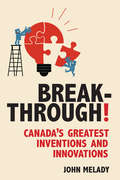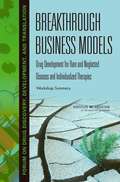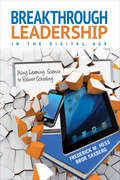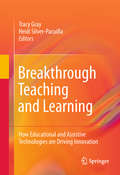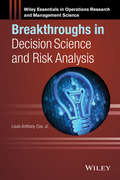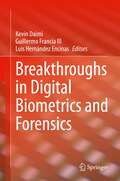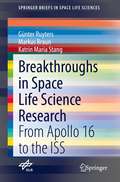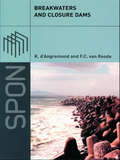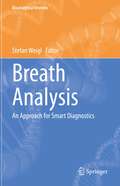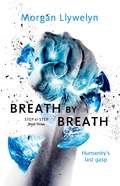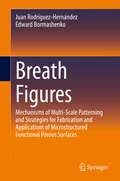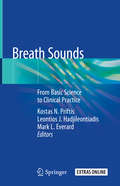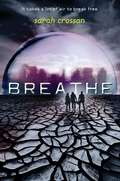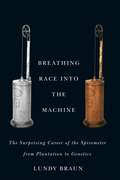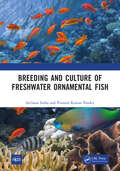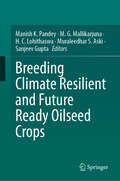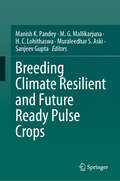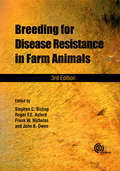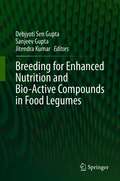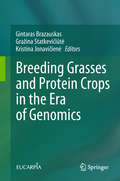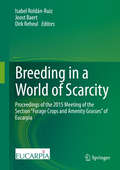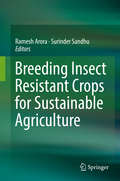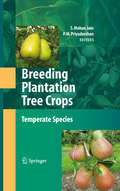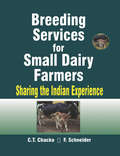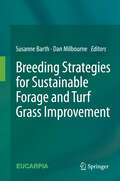- Table View
- List View
Breakthrough!: Canada's Greatest Inventions and Innovations
by John MeladyFrom the jetliner and the snowmobile to the pacemaker and the BlackBerry, Canadians have long been at the forefront of innovation and invention. Canadians are behind a variety of cutting-edge products, life-saving medicines, innovative machines, and fascinating ideas. Although our inventions have typically been created with little fanfare, financing, or expectation of return, they have often gone on to play important roles in day-to-day life. Our "greatest invention" is probably insulin, which millions of people depend on for life and health. But the light bulb, the Canadarm, and the BlackBerry certainly vie for that honour as well. Some of our inventions are small: the paint roller, the Robertson screwdriver, and the crash position indicator – the forerunner of the black box on planes. Others are larger: the jetliner, the snow-blower, and the snowmobile. Some, such as Standard Time, are really just complex ideas while others, such as the pacemaker, are triumphs of complex technology. Put simply, Canadians are supremely innovative!
BREAKTHROUGH BUSINESS MODELS: Drug Development for Rare and Neglected Diseases and Individualized Therapies
by Institute of Medicine of the National AcademiesThe process for developing new drug and biologic products is extraordinarily expensive and time-consuming. Although large pharmaceutical companies may be able to afford the cost of development because they can expect a large return on investment, organizations developing drugs to treat rare and neglected diseases are unable to rely on such returns. On June 23, 2008, the Institute of Medicine's Forum on Drug Discovery, Development, and Translation held a public workshop, "Breakthrough Business Models: Drug Development for Rare and Neglected Diseases and Individualized Therapies," which sought to explore new and innovative strategies for developing drugs for rare and neglected diseases.
Breakthrough Leadership in the Digital Age: Using Learning Science to Reboot Schooling
by Frederick M. Hess Dr Bror V. SaxbergReboot student learning the right way! Today’s most successful school leaders are truly “learning engineers”: creative thinkers who redefine their problems and design new ways to better serve kids’ success. Technology has a critical role, but it’s the creative reinvention of schools, systems, and classrooms that has to come first. In this powerful book, best-selling author and education policy expert Rick Hess and chief learning officer Bror Saxberg show you how to become your school's learning engineer. Using cutting-edge research about learning science as a framework, you’ll: Identify specific learning problems that need solving Devise smarter ways to address them Implement technology-enabled, not technology-driven, solutions
Breakthrough Teaching and Learning: How Educational and Assistive Technologies are Driving Innovation
by Tracy Gray Heidi Silver-PacuillaThe many technology-related educational changes of the past decade have been propelled by even greater changes in the general consumer technology landscape. Education has become increasingly entwined with the digital consumer landscape. We are no longer asking whether digital materials and tools should be integrated into teaching and learning, but how and how well. Meanwhile, the overall academic performance of U.S. students has not kept pace with our international peers. Many policymakers have called for increased attention to students' 21st century skills and work readiness, pointing to the critical role technology should play in educational innovation. These changes mean that many mainstream accessible technologies can be used in the classroom to benefit a diverse population of learners, including students with disabilities and English language learners, reflecting the national shift from separate special education programs to more inclusive classrooms. Changes to policies and standards have pushed assistive and accessible technologies to the forefront, including the Higher Education Opportunity Act of 2008, which requires teacher preparation programs to address educational technology and principles of universal design for learning (UDL), and the National Instructional Materials Accessibility Standard (NIMAS), which creates a public-private infrastructure to provide more timely delivery of digital text to students with physical and print disabilities. This volume represents pioneering ideas that examine how accessible educational technologies can be harnessed for breakthrough learning for all students. Chapters will cover innovation trends in educational and assistive technologies, cognitive and neuroscience findings on how individual differences impact technology use and choice; the intersection of educational, leisure, health habits and exer-gaming; the use of social networking tools by students with and without disabilities; the use of social networking for teacher professional learning communities; the future of assessments for decision-making; and an analysis of the habits of mind and work traits of innovators NCTI has interviewed over the past five years.
Breakthroughs in Decision Science and Risk Analysis
by Louis Anthony Cox Jr.Discover recent powerful advances in the theory, methods, and applications of decision and risk analysis Focusing on recent advances and innovations in the field of decision analysis (DA), Breakthroughs in Decision Science and Risk Analysis presents theories and methods for making, improving, and learning from significant practical decisions. The book explains these new methods and important applications in an easily accessible and stimulating style for readers from multiple backgrounds, including psychology, economics, statistics, engineering, risk analysis, operations research, and management science. Emphasizing topics not traditionally found in DA literature, the book illustrates genuine advances in practical decision science and includes developments and trends that depart from, or break with, the standard axiomatic DA paradigm in fundamental and useful ways. The book features methods for coping with realistic decision-making challenges, including online adaptive learning algorithms, innovations in robust decision-making, and the use of a variety of models to provide more-or-less plausible explanations for available data and recommended actions. In addition, the book illustrates how these techniques can be applied to dramatically improve risk management decisions. Breakthroughs in Decision Science and Risk Analysis also includes: An emphasis on new approaches rather than classical and traditional ideas Discussions of how decision and risk analysis can be applied to improve high-stakes policy and management decisions Coverage of the potential value and realism of decision science within applications in financial, health, safety, environmental, business, engineering, and security risk management Innovative methods for deciding what to do when decision problems are not completely known or described or when useful probabilities cannot be specified Recent breakthroughs in the psychology and brain science of risky decisions, mathematical foundations and techniques, and integration with learning and pattern recognition methods from computational intelligence Breakthroughs in Decision Science and Risk Analysis is an ideal reference for researchers, consultants, and practitioners in the fields of decision science, operations research, business, management science, engineering, statistics, and mathematics. The book is also an appropriate guide for managers, analysts, and decision and policy makers in the areas of finance, health and safety, environment, business, engineering, and security risk management.
Breakthroughs in Digital Biometrics and Forensics
by Kevin Daimi Guillermo Francia Luis Hernández EncinasThis book focuses on a wide range of breakthroughs related to digital biometrics and forensics. The authors introduce the concepts, techniques, methods, approaches and trends needed by cybersecurity specialists and educators for keeping current their biometrics and forensics knowledge. Furthermore, the book provides a glimpse of future directions where biometrics and forensics techniques, policies, applications, and theories are headed. Topics include multimodal biometrics, soft biometrics, mobile biometrics, vehicle biometrics, vehicle forensics, integrity verification of digital content, people identification, biometric-based cybercrime investigation, among others. The book is a rich collection of carefully selected and reviewed manuscripts written by diverse digital biometrics and forensics experts in the listed fields and edited by prominent biometrics and forensics researchers and specialists.
Breakthroughs in Space Life Science Research: From Apollo 16 to the ISS (SpringerBriefs in Space Life Sciences)
by Günter Ruyters Markus Braun Katrin Maria StangThis last volume of the SpringerBriefs in Space Life Sciences series is setup in 5 main parts. The 1st part shortly summarizes the history of life science research in space from the late 40s until today with focus on Europe and Germany, followed by a part on describing flight opportunities including the Space Shuttle/Spacelab system and the International Space Station ISS; in the 3rd part it focuses on extraordinary success stories of this constantly challenging research program and highlights some important key findings in space life science research. The book introduces in the 4th part innovative developments in non-invasive biomedical diagnostics and training methods for astronauts that emerge from this program and are of benefit for people on Earth especially in the aging society. Last but not least in its 5th part it closes with an outlook on the future of space life sciences in the upcoming era of space exploration. The book is intended for students and research scientists in the life sciences and biomedicine as well as for interested lay persons, who wish to get an overview of space life science research: its´ early days, current status and future directions.
Breakwaters and Closure Dams
by Kees d'Angremond F. van RoodeBreakwaters and closure dams belong to the most spectacular hydraulic structures. They are exposed to the most severe loading by waves and currents, either during their construction, or during their life cycle. Design and construction of these structures are so vitally interrelated that a proper understanding requires a thorough knowledge of the th
Breath Analysis: An Approach for Smart Diagnostics (Bioanalytical Reviews #4)
by Stefan WeiglThis volume highlights the potentials as well as the limits and challenges of human breath analysis and describes the current efforts made to advance this promising technology from bench to bed. Human breath analysis is a young, interdisciplinary and innovative research field aiming to provide a smart and non-invasive diagnostic tool, which can be used for screening, detecting and monitoring of diseases or metabolic disorders. This book presents different approaches for breath analysis including real-time and offline mass spectrometry as well as optical and semiconductor gas sensing methods. Besides, the role of smart algorithms to improve the performance of those technologies and the importance of pulmonary function diagnostics for more reliable and meaningful breath analysis are highlighted. Finally, current application scenarios and future perspectives of breath analysis and pulmonary functioning tests are addressed.The volume is useful for researchers, who are new in the field, to easily get an overview of the current status and the challenges present in human breath analysis. Topics from fundamental research over targeted sensor development and application scenarios are described. Thus, this volume covers all development stages providing support and inspiration for engineers, medical doctors and scientists from various fields.
Breath by Breath: Book Three Step by Step (Step by Step #3)
by Morgan LlywelynBreath by Breath is the explosive conclusion to the near-future, science fiction thriller trilogy Step by Step from the bestselling author Morgan Llywelyn and follows the events of Drop by Drop and Inch by Inch.In Breath by Breath, book three in the trilogy, the residents of Sycamore River have weathered the Change and the nuclear war it provoked. They emerge to try to build a life from the shattered remains of their town.But for some, the very air has become toxic.The people of Sycamore River have to survived the unthinkable. Can they build something new from the ashes?Llywelyn blends her signature character-driven portrait of small-town life with the appeal of William Fortschen's One Second After.At the Publisher's request, this title is being sold without Digital Rights Management Software (DRM) applied.
Breath Figures: Mechanisms of Multi-scale Patterning and Strategies for Fabrication and Applications of Microstructured Functional Porous Surfaces
by Juan Rodríguez-Hernández Edward BormashenkoThis book offers a complete and concise overview of the different strategies used to prepare microstructured surfaces employing information regarding surface instabilities and physical processes. Based upon the concept of the remarkably uniform layer of water vapor that is applied when one simply breathes onto a surface in cold temperatures, the book presents a comprehensive treatise addressing chemical and physical fundamentals, fabrication, and applications of the breath figures approach to surface wetting, coating, and modification (breath figures self-assembly) of various materials. The main topics of the book are divided into six parts: the control of surface properties in polymer blends; block copolymer design with the aim of providing order at different lengths; combination of block copolymer blends with the breath figures (BFs); dynamic templating; the breath figures method; biorecognition; and alternative approaches for surface structuring and functionalization.Discusses various physical processing methods in preparing microstructured surfaces;Describes relevant aspects of micro- and nanostructured surfaces from fabrication to final applications, including additive manufacturing, bacterial adhesion and entrapment, optical and electro-optical applications, and membrane technology; Details the breath figures approach to surface structuring while discussing alternative strategies that tie morphology to functionality of materials.
Breath Sounds: From Basic Science To Clinical Practice
by Kostas N. Priftis Leontios J. Hadjileontiadis Mark L. EverardThis book offers up-to-date information on the recording and analysis of respiratory sounds that will assist in clinical routine. The opening sections deliver basic knowledge on aspects such as the physics of sound and sound transmission in the body, a clear understanding of which is key to good clinical practice. Current techniques of breath sound analysis are described, and the diagnostic impact of advances in the processing of lung sound signals is carefully explained. With the aid of audio files that are available online, detailed guidance is then provided on differentiation of normal and abnormal breath sounds and identification of the various sounds, including crackles, wheezes, other lung sounds, cough sounds, and sounds of extrathoracic origin. The book is of high educational value and represents an excellent learning tool at pre- and postgraduate levels. It will also appeal to researchers as it provides comprehensive summaries of knowledge in particular research fields. The editors bring high-level expertise to the subject, including membership of the European Respiratory Society Task Force on the standardization of categories and nomenclature for breath sounds.
Breathe
by Sarah CrossanInhale. Exhale. Breathe. Breathe. Breathe . . . The world is dead. The survivors live under the protection of Breathe, the corporation that found a way to manufacture oxygen-rich air. Alina has been stealing for a long time. She's a little jittery, but not terrified. All she knows is that she's never been caught before. If she's careful, it'll be easy. If she's careful. Quinn should be worried about Alina and a bit afraid for himself, too, but even though this is dangerous, it's also the most interesting thing to happen to him in ages. It isn't every day that the girl of your dreams asks you to rescue her. Bea wants to tell him that none of this is fair; they'd planned a trip together, the two of them, and she'd hoped he'd discover her out here, not another girl. And as they walk into the Outlands with two days' worth of oxygen in their tanks, everything they believe will be shattered. Will they be able to make it back? Will they want to?
Breathing Race into the Machine: The Surprising Career of the Spirometer from Plantation to Genetics
by Lundy BraunHow race became embedded in a medical instrument In the antebellum South, plantation physicians used a new medical device—the spirometer—to show that lung volume and therefore vital capacity were supposedly less in black slaves than in white citizens. At the end of the Civil War, a large study of racial difference employing the spirometer appeared to confirm the finding, which was then applied to argue that slaves were unfit for freedom. What is astonishing is that this example of racial thinking is anything but a historical relic.In Breathing Race into the Machine, science studies scholar Lundy Braun traces the little-known history of the spirometer to reveal the social and scientific processes by which medical instruments have worked to naturalize racial and ethnic differences, from Victorian Britain to today. Routinely a factor in clinical diagnoses, preemployment physicals, and disability estimates, spirometers are often &“race corrected,&” typically reducing normal values for African Americans by 15 percent.An unsettling account of the pernicious effects of racial thinking that divides people along genetic lines, Breathing Race into the Machine helps us understand how race enters into science and shapes medical research and practice. Honorable Mention, 2017 Rachel Carson Prize, Society for the Social Studies of Science Winner of the 2018 Ludwik Fleck Prize from the Society for Social Studies of Science
Breeding and Culture of Freshwater Ornamental Fish
by Archana Sinha Pramod Kumar PandeyThis book deals with recent and upcoming technologies of breeding freshwater ornamental fish. It covers in detail areas such as status, breeding techniques, food and health management and marketing of freshwater ornamental fishes. There is a separate chapter on breeding of indigenous freshwater ornamental fishes. Emphasis is given on national and international legislation related to ornamental fish export and import. The book contains a useful chapter on the importance and role of ornamental plants and accessories. Aquarium making, decoration, water quality management and maintenance have also been well explained for hobbyists. This title has been co-published with NIPA. Not for sale in South Asia (India, Sri Lanka, Nepal, Bangladesh, Pakistan and Bhutan)
Breeding Climate Resilient and Future Ready Oilseed Crops
by Manish K. Pandey M. G. Mallikarjuna H. C. Lohithaswa Muraleedhar S. Aski Sanjeev GuptaThis edited book covers the application of modern genomics tools for developing climate-smart oilseed cultivars. The book's prime focus is on utilizing available oilseed genomic resources and application of next-generation genetics and breeding tools, viz. genome-wise association mapping, genomic selection, genome editing and accelerated breeding pipelines and their efficacy for rapid development and delivery of stress-resilient oilseeds cultivars. Oilseeds are crucial for human and animal nutrition and cater to diverse industrial applications. Besides oil content, the oilseed meal possesses proteins and a higher proportion of essential amino acids, which benefit human well-being. Additionally, the contribution of oilseeds towards renewable energy mitigates the risk of climate change by reducing carbon footprint. Hence, it is imperative to enhance oilseeds production from the current 178 to 282 million tons by 2050 to meet the demands of both the population and the environment. The current genomics era delivered various genomic resources in oilseed crops, which resulted in the discovery of genes for several agronomic and stress-resilience traits and resistance to pests and diseases. Further, the availability of next-generation plant breeding tools, such as genomic selection, genome editing, and speed breeding, are being implemented along with traditional and marked assisted selection. Thus, the book is framed to compile the importance and utility of next-generation breeding tools for enhancing stress resilience in oilseed crops in the climate change era. The book is exciting and valuable to national and international agricultural scientists, scholars and graduate students associated with oilseed crops improvement in specific and field crops in generic. The book also serves as reference in formulating various oilseed improvement programs for policymakers and research grant managers.
Breeding Climate Resilient and Future Ready Pulse Crops
by Manish K. Pandey M. G. Mallikarjuna H. C. Lohithaswa Muraleedhar S. Aski Sanjeev GuptaThis edited volume covers the application of modern breeding tools for developing climate-smart pulse crop cultivars. The primary focus is on utilizing available genomic resources and next-generation breeding technologies such as genome-wide association mapping, genomic selection, genome editing, and accelerated breeding pipelines for the rapid development of stress-resilient, systems-specific pulse cultivars. Pulses contribute to 10% of global daily protein intake and 5% of energy. Their ability to fix atmospheric nitrogen and serve as an alternative protein source to meat makes them crucial in combating global warming. With the global population expected to reach 9.8 billion by 2050, pulses production needs to increase by at least 70% to meet demand. However, pulses production is facing growing biotic and abiotic challenges, exacerbated by climate change. Thus, developing next-generation climate-smart cultivars is essential to ensure food and nutritional security. Recent efforts by global and national breeding communities have led to the discovery of new genomic resources, shifting breeding from phenotype-based to genome-based approaches. These advances integrate rapid generation advancement pipelines with genomic-assisted breeding, trait mapping, and genome editing tools. This book is valuable for agricultural scientists, scholars, and graduate students involved in pulse crop improvement. It also serves as a reference for policymakers and research grant managers in formulating pulse research programs.
Breeding for Disease Resistance in Farm Animals (3rd edition)
by Stephen C. Bishop Roger F. E. Axford Frank W. Nicholas John B. OwenThis edition provides an updated review of the principles of animal breeding for advanced health and disease resistance. It uses examples covering many diseases of importance to livestock production across all major livestock species. Topics include techniques and approaches, viruses, Transmissible Spongiform Encephalopathies (TSEs), bacteria, parasites, vectors, and broader health issues seen in production systems, including metabolic diseases.
Breeding for Enhanced Nutrition and Bio-Active Compounds in Food Legumes
by Debjyoti Sen Gupta Sanjeev Gupta Jitendra KumarMore than 20 million childhood deaths occur every year due to the micronutrient deficiency and diet-related non-communicable diseases (cardiovascular diseases, cancers, chronic respiratory diseases and diabetes). The United Nations (UN) recently announced that the increase in chronic, non-communicable diseases has resulted in 36 million deaths around the world annually, claiming more lives than all other causes combined. These chronic diseases are not isolated to developed countries and are even more pronounced in the developing world. Such chronic illnesses have caused far more deaths than infectious diseases throughout the world (except Africa) in recent years. Therefore, enrichment of micronutrients in staple food crops is of paramount importance for the nutritional security in our world. Biofortification is the development of micronutrient- and/or vitamin-rich crops using traditional crop improvement practices as well as modern biotechnology tools. It is a more sustainable and cost effective method than food supplementation, fortification and diet diversification. This work consolidates available information on the different aspects of breeding for improved nutrition of pulses. An overview of entire pulses based on their nutritional profile is given so that audience can find the desired information easily. Food legumes are the active ingredients in many gluten-free food products and there is a continuous rise of the use of pulses flour in milling and baking processes. Our book sheds light on recent efforts and the underlying constraints of meeting the public demand. We believe this work provides the basic information for anyone interested in biofortification and stimulate further research to meet this unique challenge.
Breeding Grasses and Protein Crops in the Era of Genomics
by Kristina Jonavičienė Gražina Statkevičiūtė Gintaras BrazauskasThis book includes papers presented at the 2017 Joint meeting of Fodder Crops and Amenity Grasses Section and Protein Crops Working Group of EUCARPIA-Oil and Protein Crops Section. The theme of the meeting “Breeding Grasses and Protein Crops in the Era of Genomics” has been divided into six parts: (1) Utilisation of genetic resources and pre-breeding, (2) Genetic improvement of quality and agronomic traits, (3) Breeding for enhanced stress tolerance (4) Implementation of phenomics and biometrics, (5) Development of genomic tools and bioinformatics and (6) Reports of Parallel Sessions.
Breeding in a World of Scarcity: Proceedings of the 2015 Meeting of the Section “Forage Crops and Amenity Grasses” of Eucarpia
by Isabel Roldán-Ruiz Joost Baert Dirk ReheulThis book includes papers presented at the 2015 meeting of the Fodder Crops and Amenity Grasses Section of Eucarpia. The theme of the meeting "Breeding in a world of scarcity" was elaborated in four sessions: (1) scarcity of natural resources, (2) scarcity of breeders, (3) scarcity of land and (4) scarcity of focus. Parts I to IV of this book correspond to these four sessions. Session 1 refers to the consequences of climate change, reduced access to natural resources and declining freedom in using them. Plant breeding may help by developing varieties with a more efficient use of water and nutrients and a better tolerance to biotic and abiotic stresses. Session 2 refers to the shrinking number of field breeders. There is a need for a mutual empathy between field- and lab-oriented breeding activities, integrating new methods of phenotyping and genotyping. Session 3 underscores the optimal use of agricultural land. Forage needs to be intensively produced in a sustainable way, meeting the energy, protein and health requirements of livestock. Well-adapted varieties, species and mixtures of grasses and legumes are needed. Session 4 refers to the fading of focus in primary production triggered by a range of societal demands. There are few farmers left and they are asked to meet many consumer demands. Both large-scale, multi-purpose species and varieties and specialized niche crops are required. Part V summarizes the conclusions of two open debates, two working group meetings and two workshops held during the conference. The debates were devoted to the future of grass and fodder crop breeding, and to feed quality breeding and testing. The conference hosted meetings of the working groups "Multisite rust evaluation" and "Festulolium". Workshops focused on "genomic selection and association mapping" and on "phenotyping" with applications in practical breeding research. Part V contains also short sketches of breeding ideas presented as short communications.
Breeding Insect Resistant Crops for Sustainable Agriculture
by Ramesh Arora Surinder SandhuThis book reviews and synthesizes the recent advances in exploiting host plant resistance to insects, highlighting the role of molecular techniques in breeding insect resistant crops. It also provides an overview of the fascinating field of insect-plant relationships, which is fundamental to the study of host-plant resistance to insects. Further, it discusses the conventional and molecular techniques utilized/useful in breeding for resistance to insect-pests including back-cross breeding, modified population improvement methods for insect resistance, marker-assisted backcrossing to expedite the breeding process, identification and validation of new insect-resistance genes and their potential for utilization, genomics, metabolomics, transgenesis and RNAi. Lastly, it analyzes the successes, limitations and prospects for the development of insect-resistant cultivars of rice, maize, sorghum and millet, cotton, rapeseed, legumes and fruit crops, and highlights strategies for management of insect biotypes that limit the success and durability of insect-resistant cultivators in the field. Arthropod pests act as major constraints in the agro-ecosystem. It has been estimated that arthropod pests may be destroying around one-fifth of the global agricultural production/potential production every year. Further, the losses are considerably higher in the developing tropics of Asia and Africa, which are already battling severe food shortage. Integrated pest management (IPM) has emerged as the dominant paradigm for minimizing damage by the insects and non-insect pests over the last 50 years. Pest resistant cultivars represent one of the most environmentally benign, economically viable and ecologically sustainable options for utilization in IPM programs. Hundreds of insect-resistant cultivars of rice, wheat, maize, sorghum, cotton, sugarcane and other crops have been developed worldwide and are extensively grown for increasing and/or stabilizing crop productivity. The annual economic value of arthropod resistance genes developed in global agriculture has been estimated to be greater than US$ 2 billion Despite the impressive achievements and even greater potential in minimizing pest- related losses, only a handful of books have been published on the topic of host-plant resistance to insects. This book fills this wide gap in the literature on breeding insect- resistant crops. It is aimed at plant breeders, entomologists, plant biotechnologists and IPM experts, as well as those working on sustainable agriculture and food security.
Breeding Plantation Tree Crops: Temperate Species
by P. M. Priyadarshan Shri Mohan JainTree species are indispensable to human needs. Due to their long life cycle and environmental sensitivity, breeding trees for sustainable production is a formidable challenge in order to meet the demands of growing human population and industries. Fruit crops such as apple, cocoa, mango, citrus, litchi, pear, dates, and coconut or industrial crops including rubber and tea, improving yield under the optimal, sub-optimal and marginal areas call for a unified worldwide effort. While the uniqueness of coconut as 'kalpavriksha' (Sanskrit - meaning tree of life) makes its presence in every continent from Far East to South America, tree crops such as cocoa, oil palm, rubber, apple, peach and walnut prove their environmental sensitivity towards tropical, subtropical and temperate climates. Date palm is quintessential for desert climate. Thus, from soft drinks to breweries to oil to tires, the value addition offers a spectrum of products to human kind, enriched with nutritional, environmental, financial, and trade related attributes. This volume is a compilation of information on breeding of temperate tree species and provides first hand comprehensive knowledge to research, teach, and make policies.
Breeding Services for Small Dairy Farmers: Sharing the Indian Experience
by C T ChackoBetter validation of indigenous domestic animal genetic resources is becoming more important with regard to the potential of livestock for poverty alleviation and income generation. To improve indigenous breeds for sustainable income and employment generation, the methods to be employed are the same as developed in systematic breeding programs, be it for cross-breeding or selective breeding within a specific breed. This book systematically introduces the reader to the breed improvement theory and illustrates the theory with practical examples and case studies. The book is addressed to animal science teachers, to undergraduate and postgraduate students as well as to decision makers in the state and central livestock departments.
Breeding strategies for sustainable forage and turf grass improvement
by Dan Milbourne Susanne BarthFrom the 4th - 8th of September 2011, the Eucarpia Fodder Crops and Amenity Grasses Section, held its 29th Meeting in the surroundings of Dublin Castle in Ireland. The theme of the meeting was 'Breeding strategies for sustainable forage and turf grass improvement'. Grasslands cover a significant proportion of the land mass of the world, and play a pivotal role in global food production. At the same time we are faced with several challenges that affect the way in which we think about this valuable set of resources. The population of the world is expected to exceed 9 billion by 2050, and increase of about one third relative to today's levels. This population increase will be focused in urban areas, and in what are currently viewed as "developing" countries, meaning that the buying power of this increased population will be greater - shifting the balance of demand from staple crops to high value items such as meat and dairy products. Overall that the world will have to approximately double agricultural output across all categories of food to meet the demands of this larger, urbanised population. This is occurring against a backdrop of equally large challenges in terms of global climate change. Agriculture is already a significant contributor to e.g. greenhouse gas emissions, deforestation and soil erosion. The situation is made more complex by an increased emphasis on biofuels as a solution for our imminent oil shortage, resulting in increased competition between land utilised for food and fuel. In short, agriculture must continue to feed the world, whilst not contributing to damaging it further. It must be sustainable. Plant breeding plays a significant but frequently understated role in meeting the challenges presented by this complex and changing scenario. However, plant breeding and improvement is itself undergoing radical change driven by technology. This book explores how forage and turf breeding is changing and adapting to meet these challenges using the technological advances being experienced in plant breeding as a whole.
